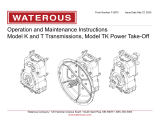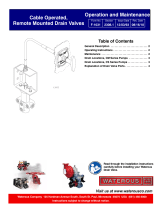Page is loading ...

Waterous Fire Pumps may be ordered with a variety of accessories.
Refer to the following separate installation instructions as necessary:
Auto Tank Fill System
Butterfly Valves
CAF System
Discharge Valves
Drain Valves
Foam System:
Foam Pump
Foam Pump Flush Kit
Foam Fill
Dual Foam Injection Kit
Dual Tank Selector
Overboard Foam Pick-up
Remote Start Kit
Overheat Protection Manager (OPM)
Pump Shift (Pneumatic)
Pressure Control System:
Discharge Relief Valve
Intake Relief Valve
Pressure Governor
Priming System
Waterous Company 125 Hardman Avenue South, South St. Paul, Minnesota 55075 (651) 450-5000
www.waterousco.com
Read through safety information
and installation instructions
carefully before installing your
Waterous Fire Pump.
F-2880
Issued: 12/10/20
Fire Pump Model CP-2
Installation Instructions
Note that Instructions are subject to change
without notice.
Model CPK-2
Model CPT-2
Model CPD-2

F-2880
Page 2 of 10
Table of Contents:
Safety Information…………………………………………………………… 3
Pump Intake and Discharge Connections………………………………. 4
Available Pump Drives ……………………………………………………… 4
Pump Mounting………………………………………………………………. 4
Mounting Locations:
Model CPK-2……………………………………………………………. 5
Model CPT-2……………………………………………………………. 6
Model CPD-2……………………………………………………………. 7
Optional Suspension Pin Mounting Method:
Model CPK-2 Only…………….………………………………………... 8
Optional Corrosion Protection………………………………………… 9
Final Checks:
Lubrication………………………………………………………………. 10
Testing…………………………………………………………………… 10

F-2880
Page 3 of 10
Read through and communicate safety information to the end user of this Waterous Fire Pump.

F-2880
Page 4 of 10
Pump Intake and Discharge Connections
Pump Model
Intake
Discharge
CP-2
3 in. NPT (F) or
3 in BSPT (F)
2 in. NPT (F) or
2 in. BSPT (F)
Available Pump Drives
Drive
Transmission
Complete Pump and
Transmission Model
Type
Series
Model
Input Shaft Rotation
PTO
None, Direct Drive
from PTO
D
D
Clockwise or
Counter Clockwise
CPD-2
Two Gear
Speed Increaser
K
K
Clockwise or
Counter Clockwise
CPK-2
Directly Mounted
to an Engine
Two Gear
Speed Increaser
T
T
Clockwise or
Counter Clockwise
CPT-2
Pump Mounting
Select a mounting location which will make the pump and its accessories readily accessible for maintenance and which will make the pump driveshaft parallel with
the output shaft of the chassis transmission or transfer case. Also, select the location so that when the apparatus is loaded, the universal joints on the propeller
shaft will have a proper working angle. Be sure the propeller shaft used are of the slip-joint design. Frame deflection, temperature changes and similar factors may
cause a propeller shaft without slip-joints to produce severe axial loads on the bearings and damage the pump.
Be sure to keep at least a minimum of 1° U-joint operating angle. This is the preferred method of propeller shaft installation. For additional information on this
method, or for alternative methods, see driveshaft installation guidelines such as Spicer®/Driveshaft Installation Techniques.
Driveline End Yokes and Companion Flanges: Anti seize should be applied to the shaft threads before installing end yoke or companion flange. Use self-
locking nuts supplied, torque to 275-325 lb-ft. Do not re-use nuts if end yoke or companion flange is removed.
Brackets must be fabricated to attach to the mounting points of the pump body and transmission and the chassis frame. Tighten the mounting hardware to
standard torque specifications.
Note that Waterous does not furnish the brackets.

F-2880
Page 5 of 10
Mounting Locations – Model CPK-2
Note that the Pump Discharge may be positioned Up, Right, Left or Down and the Transmission may be mounted Vertical, Right, Left or Inverted.
Refer to the configuration of the pump you ordered and Pump Dimensional Drawing for details specific to your pump.

F-2880
Page 6 of 10
Mounting Locations – Model CPT-2
Note that the Pump Discharge may be positioned Up, Right, Left or Down and the Transmission may be mounted Vertical, Right, Left or Inverted.
Refer to the configuration of the pump you ordered and Pump Dimensional Drawing for details specific to your pump.

F-2880
Page 7 of 10
Mounting Locations – Model CPD-2
Note that the Pump Discharge may be positioned Up, Right, Left or Down. The Bearing Housing will always point down.
Refer to the configuration of the pump you ordered and Pump Dimensional Drawing for details specific to your pump.

F-2880
Page 8 of 10
Optional Suspension Pin Mounting Method
Model CPK-2 Only

F-2880
Page 9 of 10
Optional Corrosion Protection
Intake Screens
Waterous offers intake screens that fit 4, 4-1/2, 5 and 6 inch intake fittings sizes.
The screen is designed to fit in the counter bore in the inside diameter of the
fittings. There must be a strong electrical contact between the screen and the
intake fitting. Remove any corrosion, debris or paint from the counter bore that will
insulate the screen from the intake fitting. If the screen does not fit tightly, adjust
the gap of the slot on the outside diameter of the screen to ensure a tight fit.
NOTE: Intake screen are die-cast which results in a slight taper from one
side to the other. Install the screen with the thinner cross-section facing out
to minimize flow restriction.
Anodes
Anodes may be mounted in the intake piping or, if no intake pads are available,
in the discharge piping.
NOTE: The replaceable elements must make contact with water to be
effective. Do not paint or use any other coating on the replaceable
elements.

F-2880
Page 10 of 10
Final Checks
Lubrication
Transmissions are shipped without lubricant and must be filled before the pump is operated.
NOTICE
Failure to properly lubricate the pump transmission may result in serious damage
to the equipment.
The types of recommended lubricants are listed below:
Transmission
Model
Capacity
(Quarts or Liters)
(See Note 1)
Lubricant
(See Note 2)
K
1
SAE 80W-90 Gear Oil
T
1
D
(No Transmission)
Bearing Housing has Sealed Bearings, Lubricant not required
Notes:
1) Capacities shown are approximate Quarts or Liters, always fill to the bottom of the plug labeled “Oil Level” or sight glass. Quantities listed vary
based on ratio and/or mounting orientation.
2) Synthetic ATF and oil substitutes are acceptable.
Testing
Perform the tests listed in F-1031, Section 1000, “Centrifugal Fire Pump Principles of Operation, Inspection Tests and Troubleshooting
Guide.” During the running tests, monitor the smoothness of operation, listen for unusual noises and check for leaks.
/










